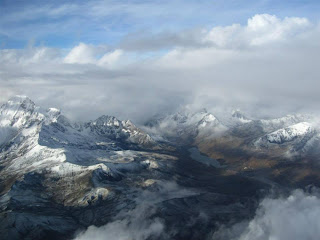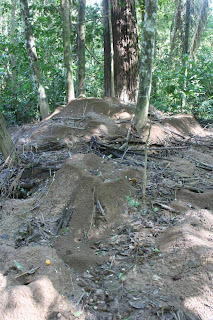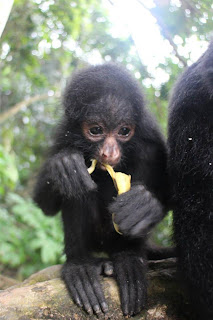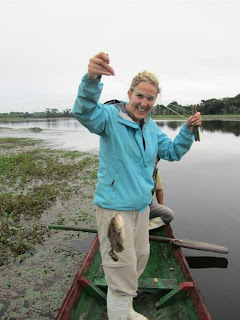See more pictures of the Amazon on Facebook.
One of the most visually spectacular parts of our trip so far was our trip to the jungle and surrounding waterways of the Amazon basin. The Madidi Mosaic is the largest and, biologically and culturally, the most diverse protected area in the world. It covers almost fifteen million hectares (with a potential of becoming thirty million) in areas from 150 meters above sea level to 6000 meters above sea level, and is home to 10% of all the species found on the planet.
Almost bursting at the seams with flora and fauna, the local wildlife in this part of Bolivia provided us with a new found respect about the importance of the delicate jungle ecosystems, an appreciation of the conservation work being done here, and plenty of photo-ops too.
Getting there
 |
| The mountains surrounding Huanapotosi |
Because of the blockades we mentioned in our last blog, when travelling from Sucre to Rurrenabaque, we decided to fly. We flew first to La Paz, then on to Rurrenabaque – taking us deep into the Amazon basin. The flight from La Paz to ‘Rurre’, as it is affectionately known, was stunning. From the city, we flew through snow-capped mountains – which slowly disappeared out from under us as we moved into the valleys of the jungle waiting below.
 |
| The endless jungle |
From the sky, the jungle appeared to stretch on forever, when suddenly a runway appeared from nowhere and the plane dropped very steeply and landed. We were surrounded on all sides by jungle, with only a small shack indicating any presence of life here. The shack, it turned out, was the airport – with a tiny fenced off area at the front separating the arrivals from the departures.
Las Pampas
We happened to meet up with friends from Macha and also a couple from our homestay in Sucre waiting for us to book a tour. We all managed to get onto the same one and took off the next morning by four-wheel drive on the nausea-inducing road to the Pampas area.
 |
| Sloth |
On the way, we saw a sloth, a notoriously lazy animal and difficult to see as they as often quite still, sleeping the day away. We were lucky enough to catch him on the move and managed to get a few pictures. After lunch, we traded the jeeps for outboard-powered skiffs, and that´s where the real animal site-seeing began. Almost immediately as we head up the river we ran into caiman, the local form of alligator, almost stacked one after another. They were all along the banks of the river, basking in the sun or cruising the river with only their eyes peaking above the murky water.
 |
| Capybaras |
We also came across a fairly large family of capybaras, the largest rodents in the worlds – similar in size to the size of a fully-grown pig. Yellow squirrel monkeys scrambled down the trees towards the boat, hoping for a few treats. We didn’t give them anything, but many of the less ecologically-concerned companies do let the tourists feed them in hope of more tips.
The pink freshwater dolphins proved more difficult to see. Slower than their salt water cousins, they simply meander along the Yucuma river, barely breaking the water when surfacing for air. They are inquisitive animals, but – as we later found out – with the number of tourists passing through each day and the increase in the number of boats, they have become shyer and more irritable, with several recent stories of them starting to bite tourists.
 |
| Speckled caiman |
Our eco-lodge was built on struts by the water to protect it from the rising water during the rainy season. While it was quite basic, the dorms had mosquito nets, and generator-powered lighting up until 9pm. After dinner we went caiman hunting – with only torches, of course. The eyes of the caiman light up and reflect like cats eyes on the road when scanning the waters with a light. Red howler monkeys has taken up residence in the trees near our lodge, but not even their slightly alarming howls could keep us awake after our first intense day of travelling.
 |
| Searching for anacondas |
On the second morning after breakfast, we were out on the boat again, off to find anacondas in the long grasses and swampy areas near the rivers. We were all wearing wellies, but you still couldn´t help feeling a little apprehensive at the thought of stumbling over an anaconda – a snake that with a healthy enough food supply can grow to a whopping 8m in length.
After hours of searching, however, we had found nothing. We were almost back to the boat when we found one hiding in the dry grasses near a farm house. The female snake was coiled up so it was difficult to properly gauge how long she was, but our guide having plenty of experience estimated she was around 2.5m. She was really beautiful and while we wouldn´t want her anywhere near our necks, she was far less scary than imagined.
 |
| Found one |
After lunch (and a well-deserved siesta), we went swimming with the dolphins, and where before they used to play they have now started biting or avoiding the tourist boats altogether. Matt and the rest of the boat jumped right in, but Aoife was quite concerned about the caiman lurking around the boat, and the piranha we would be sharing the water with. The dolphins did swim by numerous times, but weren´t interested in us at all. The muddy water also made it impossible to see anything in the water around you, and everyone seemed happy enough to get out after 20 minutes.
 |
| Swimming with dolphins (and caiman and piranha) |
On our last day in the Pampas before starting our long journey back to Rurre, we tried our hand at piranha fishing. We didn´t need much at all: a line, a hook and some meat bait all tied to a stick and we were good to go. We didn´t catch much though – a few sardines and catfish – another unfortunate indicator that this particular ecosystem is under pressure from the current levels of tourists passing through. Matt caught the fish of the day with his last piece of bait.
 |
| Spoonbills |
Along with the many reptiles and mammals we spotted, we saw plenty of interesting bird life. The most distinctive was the Serere, a prehistoric bird which looked quite like an awkward semi-flying cousin of the chicken. A juvenile hawk spent the morning hanging about our lodge, screaming for his mother – although we didn´t see any signs of him finding success. We also caught a glimpse of spoonbills, wrens, cardinals, vultures and our first blue-and-yellow macaws.
Serere Reserve
After the Pampas tour, we decided to spend another three days in the jungle at an eco-lodge in the Serere Reserve, a privately-owned 4000 hectare conservation reserve. The Pampas was great for seeing animals, but we spent most of our time in the boat and not actually trekking and really experiencing the jungle.
Serere was established by Rosa Maria Ruiz, the Bolivian conservationist and indigenous rights campaigner who fought for the creation of the Madidi National Park, so the reserve was exactly what we were looking for and we knew the people working here had their hearts in the right place. Despite being a private, the reserve is home to four lakes, an animal reintegration centre and nine ecolodges. The lodges were large and comfortable, but there was no electrcity inside the park at all, with the main living quarters using gas for the cooking and fridges, and candle-light for dinner.
 |
| Harpy Eagle |
On the day we arrived and after our two and a half hour boat ride down the Rio Beni, our guide brought us to see the nest of a Harpy Eagle. The incredibly rare eagle is the world´s most powerful raptor, and is among the largest eagles in the world. The nest was enormous, and luckily we also got to see the female eagle on partol. The guide believed there were eggs in the nest and once they hatch, both the mother and father feed the growing chicks, even plucking monkeys straight from the trees and feeding it to them whole.
 |
| Bats eating mosquitos |
Before returning to the lodge for the night, we tried our hand once more at piranha fishing. Matt and another person on our trip caught between them a dogfish, a catfish and a few small piranhas, but Aoife didn´t have any such luck. As we slowly reached our way home, twilight descended and thousands of insect-eating bats emerged from their caves in trees, skimming just above the water, feeding on all the mosquitos. It was amazing to watch them glide and swoop around the boat at great speed, only a few centimetres away from us.
 |
| Daddy long-legs as big as your face |
The second day, the weather was drizzly or overcast for most of the day, making the animals more difficult to see. We saw plenty of animal tracks, including tapir and wild pigs, but the rain ensured they remained in their hiding places. We were also lucky enough to see some incredible spiders, including the web-building spider who builds a new web every day, and the Golden-Silk Orb-Weaver – both were huge.
The rain cleared for a while and we were lucky enough to see some capuchin monkeys playing in the trees near the lodge. Both the capuchin and the yellow-squirrel monkeys live in the middle layer of the forest canopy – from 3m to 20m in height. They are very curious creatures and would follow us, watching from the safety of the trees. The largest monkeys, such as the howler and the spider, live higher up at the top of the canopy, making them more difficult to spot.
 |
| Home of the leaf-cutter ants |
On the canopy floor, more protected from the rain, we also spotted lots of different types of ants. Leaf-cutter ants had very impressive any hills with millions of ants living in each colony. The ants themselves were small, but strong and able to carry the leaves quite far. If the ant hill was attacked, however, the leaf-cutters have soldier ants, which are much bigger and stronger, whose sole purpose is to protect the hill. Their cutter jaws, once they clamp down, are very difficult to remove and soldier ants used to used in places of stitches for keeping wounds shut by local people. Once they had clamped down, they broke the rest of the body off, and voila – closed.
We also saw fire, army and bullet ants, with the bullet ant being the largest in the world. The weather cleared in the afternoon and we were able to visit some of the more remote lakes, Gringo and Isla. We also got to visit the monkey rescue area, where semi-independent spider monkeys are being reintroduced into the wild. Many of the monkeys were pets of people living in town, but once they get bigger they tend to become aggressive and start biting, and they are then given to the rescue centre. One very young monkey was handed into the rescue centre by hunters who had killed his mum. An older rescued monkey adopted him, which means less human intervention is required.
 |
| Pepé showing off the fire |
 |
| The adoptee. |
The monkeys were very cute and affectionate, despite being semi-wild and free to roam as they pleased. They were happy to lead us around by the hand and show us things of interest to them, such as the fire, where their minder was boiling some water. They sleep high up in the tops of the trees, but when they heard us returning later that evening they shuffled down and begged to be lifted up for a cuddle. The night air was cold and apparently they love a little extra body warmth to help keep them warm. Pepé, a younger male took a particular liking to Matt. It was amazing how human they were and even took offence when you pulled your hand away from them, or when they were trying to show you something. Unfortunately for them, because the spider monkeys live solely on a diet of fruit, they are meant to be quite delicious and the locals have eaten to the point of extinction in this particular spot. Until these pets are old enough to take care of themselves in the wild, there wont be any truly wild spider monkeys found here.
 |
| Monkeys love swinging, believe it or not |
The same evening, we tried piranha fishing at another location. This time we had more luck and even Aoife caught one at the last throw of her hook. They were all different types – white, blue and yellow, although none of the more aggressive red variety – and made for a pretty good feed that night. While we didnt see a jaguar or its smaller cousin, the ocelot, we did see their tracks. The ocelot had even passed over our tracks and may have been following us, as they are curious even though they are very shy.
 |
| Ocelot tracks |
 |
| Aoifes piranha |
One our last day, we went wild pig hunting – not to kill, but simply to spot them. They travel in groups of over 50, but are notoriously difficult to spot as they bolt with even the slighest noise. We could hear them breaking nuts with their strong teeth, but every time we thought we had them, they kept moving off in the other direction. We did however, spot a family of red raccoons and visited a giant hollowed tree filled with bats waiting for night fall. At the lodge, there also lived two red-and-blue macaws and two smaller Amazonian green parrots. The wings of one of the macaws and one of the parrots had been clipped by their previous owners, but they were slowly growing back and strengthening. Eventually they will be able to fly away and live independently.
Final thoughts
The Amazon basin in Bolivia is amazing and covers almost a third of the entire country. Unfortunately Bolivia, because it is so cheap and a little basic, seems to attract a younger crowd who are more interested in partying, cheap drinks and cheap tours as opposed to travellers actually interested in the culture or in the environment. Many tours into the jungle and the Pampas are run by companies jumping on the tourism bandwagon and adding to the over supply of tour operators. The guides are often not trained or qualified and do not follow conservation practices, such as not touching or interfering with the animals. Tourists unfortunately add to the problem by expecting and demanding to see animals, instead of seeing any sightings as a priviledge. Guides driven by the need for tips often grab the animals, create unnecessary stress and sometimes even miss treat them.
In the end, we paid a little more for our trips, but had a really great experience as a result. The other people on the trip were similarly conscious of limiting our impact on the animals. We didn’t have pictures with the snakes around our necks, baby caiman in our mouths or the cute squirrel monkeys on our boat so we could feed them. Many tourists didnt even see this as a major problem and dont think twice when a guide offers it to you for a picture.
After being to the Galapagos, though, you really see the difference in animal behaviour when the animals have not been stressed by humans. The animals, even the birds, don’t fly away when you approach , baby seals come to you and reptiles take the short cut through your legs instead of staying clear. The result is one of mutual curiosity and ultimately leads to much better experiences.


